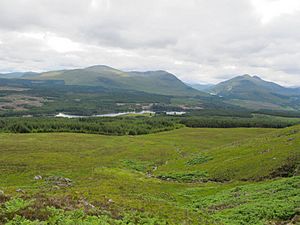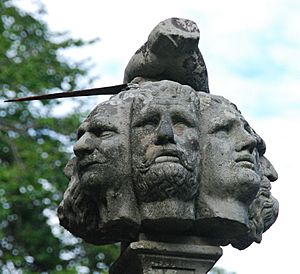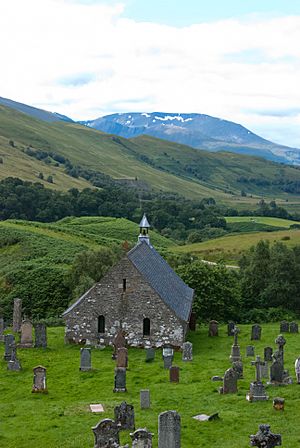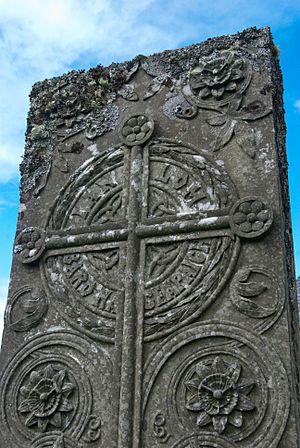Iain Lom facts for kids
John MacDonald, also known as Iain Lom (born around 1624, died around 1710), was a famous Scottish Gaelic poet. His nickname "Iain Lom" means "Bald John" or "Plain-spoken John." He was also called "Iain Manntach," which means "Stammering John," perhaps because he had a speech difficulty.
Contents
Life Story of Iain Lom
Iain Lom's family were part of the Clan MacDonald of Keppoch. They were like minor nobles in their area. His family lived on land called Allt a' Chaorainn, which is near the Laggan dam today. People in the area say that a ruined old house near the road was once Iain Lom's home.
We don't know exactly when Iain Lom was born or died. But we know he was an adult at the Battle of Inverlochy in 1645. He also wrote about the Treaty of Union in 1707. This suggests he was born in the early to mid-1620s and died in the early 1700s. Most of what we know about him comes from what others said at the time and from his own poems.
There's a story that he went to college in Spain when he was young. Some people think he might have been expelled for doing something wrong.
Iain Lom might have had a limp. Someone from his time described him as "walking with a hirple," which means a limp. However, this is a bit confusing because another story says he walked a long way to warn a general named Montrose. He then guided Montrose's army through snowy hills to surprise their enemies at Inverlochy in 1645. This march was very difficult, and Montrose's own son died a month later because of it.
It's believed that Iain Lom accidentally killed his own brother during a fight. His father also died in that same battle. After this, Iain Lom refused to use a sword in battle. At Inverlochy, when he was offered a sword, he said, "You fight and I'll narrate." His long poem about the battle, Là Inbhir Lochaidh ("The Day of Inverlochy"), is a very important piece of Scottish Gaelic literature. It also helps us understand the history of the battle.
Even with a possible limp, Iain Lom was said to have climbed a tree during the Battle of Inverlochy. When his Chief questioned him about it, Iain Lom replied that he climbed the tree to get a better view of his chief and clansmen fighting bravely. He also said that if he had been killed in the battle, no one would have been left to write poems about their heroic deeds.
Many stories tell of Iain Lom's quick and sharp wit, even from a young age. He felt things very strongly, especially his dislike for Clan Campbell. This is clear in his poem Là Inbhir Lochaidh (The Day of Inverlochy):
|
Sgrios oirbh mas truagh leam bhur càramh |
Destruction on you if I feel pity for your plight |
Many people think Robert Burns was Scotland's first official poet. But King Charles II actually named Iain Lom as a poet laureate during his rule. Later, another MacDonald poet was also named poet laureate by Prince Charles Edward Stuart. However, the Stuart kings lost their power, so these titles didn't have the same official meaning in the long run. Also, Iain Lom wrote only in Gaelic, which was a language facing challenges at the time.
Iain Lom played a big part in getting justice for the Keppoch murders. When the chief Dòmhnall Glas II died, his heir, Alasdair, was too young to rule. His uncle, Alasdair Buidhe, became the temporary leader. When young Alasdair and his brother returned from their education, a party was held. But during this party, both brothers were murdered by seven men from another family who wanted to be chief.
Iain Lom asked the Clan MacDonald of Glengarry for help, but they didn't do anything. So, he had to leave his home for a while. He then asked Sir James of Clan MacDonald of Sleat for permission to get revenge for the murders. This finally happened in 1665. The murderers were surprised and killed in a house. It's said that Iain Lom personally killed all seven of them. He wrote a poem about this event called Murt na Ceapaich (The Keppoch murders).
Iain Lom is also believed to have been at the Battle of Killiecrankie in 1689, when he would have been in his mid-sixties. Two poems about this battle are thought to be his. He didn't like William of Orange, calling him "a borrowed king." He also criticized Queen Mary for not being loyal to her father. Iain Lom strongly condemned the Massacre of Glencoe in his Gaelic poem Murt Ghlinne Comhann. He believed that the entire Clan Campbell should lose their lands because of this betrayal. His poem Òran an Aghaidh an Aonaidh (A Song Against the Union) strongly criticized the Scottish nobles who voted for the Act of Union 1707. This is thought to be his last work, and it's believed he died soon after.
His Poems and Writings
Iain Lom's work shows a change in Gaelic poetry. Before him, poets often wrote formal praise poems for chiefs in an older, classical Gaelic language. Iain Lom, however, wrote in the everyday Gaelic spoken at his time. He was a very political poet. He strongly opposed the English Puritans and the Scottish Covenanters. Later, he was against William of Orange becoming king and also later governments. He was always loyal to the House of Stuart, who were the former kings, making him an early Jacobite. As a clan poet, he wrote about the battles and events involving the Keppoch clan, especially when they fought for the Stuarts.
Some of his well-known works include poems about:
- The Battle of Inverlochy
- Alasdair MacColla (a famous warrior)
- The Keppoch murders
- The Massacre of Glencoe (where his relatives were killed)
- The Restoration (when the Stuart kings returned)
- The Hanoverian succession (when a new royal family took over)
- The Act of Union 1707 (which joined Scotland and England)
His Family
Iain Lom had a sister who was married to Alexander MacDonald of Inverlair. This Alexander was involved in the Keppoch murders. However, Iain Lom didn't mention this in his poems and seemed to stay on good terms with his sister.
Some people say Iain Lom never married, but others believe he had a son. This son was also a good poet. He was killed in a fight by Dòmhnall Donn, another poet who was related to the Keppoch murderers. Dòmhnall Donn was a famous cattle thief. When Dòmhnall Donn was waiting to be executed, Iain Lom, who had influence, did not try to help him.
Where He is Buried
Iain Lom is thought to be buried in the churchyard of Cille Choiril. This is east of Roy Bridge and close to his old home. We don't know the exact spot of his grave. However, a man named Charles Fraser-Mackintosh put up a nice memorial stone for him there in the late 1800s.
Iain Lom in Stories
Iain Lom appears as a character in the novel John Splendid (1898) by Neil Munro.






